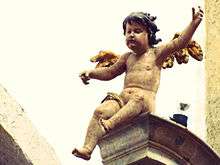Putto
A putto (Italian: [ˈputto]; plural putti [ˈputti])[1] is a figure in a work of art depicted as a chubby male child, usually naked and sometimes winged. Originally limited to profane passions in symbolism,[2] the putto came to represent the sacred cherub (plural cherubim),[3] and in Baroque art the putto came to represent the omnipresence of God.[2] A putto representing a cupid is also called an amorino (plural amorini) or amoretto (plural amoretti).
%2C_da_villa_arianna_a_stabia%2C_9180.jpg)
Etymology
The more commonly found form putti is the plural of the Italian word putto. The Italian word comes from the Latin word putus, meaning "boy" or "child".[4] Today, in Italian, putto means either toddler winged angel or, rarely, toddler boy. It may have been derived from the same Indo-European root as the Sanskrit word "putra" (meaning "boy child", as opposed to "son"), Avestan puθra-, Old Persian puça-, Pahlavi (Middle Persian) pus and pusar, all meaning "son", and the New Persian pesar "boy, son".
Putti, in the ancient classical world of art, were winged infants that were believed to influence human lives. In Renaissance art, the form of the putto was derived in various ways including the Greek Eros or Roman Amor/Cupid, the god of love and companion of Aphrodite or Venus; the Roman, genius, a type of guardian spirit; or sometimes the Greek, daemon, a type of messenger spirit, being halfway between the realms of the human and the divine.[5]
Revival of the putto in the Renaissance
Putti are a classical motif found primarily on child sarcophagi of the 2nd century, where they are depicted fighting, dancing, participating in bacchic rites, playing sports, etc.
The putto disappeared during the Middle Ages and was revived during the Quattrocento. The revival of the figure of the putto is generally attributed to Donatello, in Florence in the 1420s, although there are some earlier manifestations (for example the tomb of Ilaria del Carretto, sculpted by Jacopo della Quercia in Lucca). Since then, Donatello has been called the originator of the putto because of the contribution to art he made in restoring the classical form of putto. He gave putto a distinct character by infusing the form with Christian meanings and using it in new contexts such as musician angels. Putti also began to feature in works showing figures from classical mythology, which became popular in the same period.
Most Renaissance putti are essentially decorative and they ornament both religious and secular works, without usually taking any actual part in the events depicted in narrative paintings. There are two popular forms of the putto as the main subject of a work of art in 16th-century Italian Renaissance art: the sleeping putto and the standing putto with an animal or other object.[6]
Where putti are found

Putti, cupids, and angels (see below) can be found in both religious and secular art from the 1420s in Italy, the turn of the 16th century in the Netherlands and Germany, the Mannerist period and late Renaissance in France, and throughout Baroque ceiling frescoes. So many artists have depicted them that a list would be pointless, but among the best-known are the sculptor Donatello and the painter Raphael. The two relaxed and curious putti who appear at the foot of Raphael's Sistine Madonna are often reproduced.[7]
They also experienced a major revival in the 19th century, where they gamboled through paintings by French academic painters, from Gustave Doré’s illustrations for Orlando Furioso to advertisements.
Iconography of the putto
The iconography of putti is deliberately unfixed, so that it is difficult to tell the difference between putti, cupids, and various forms of angels. They have no unique, immediately identifiable attributes, so that putti may have many meanings and roles in the context of art.
Some of the more common associations are:
- Associations with Aphrodite, and so with romantic—or erotic—love
- Associations with Heaven
- Associations with peace, prosperity, mirth, and leisure
Historiography
The historiography of this subject matter is very short. Many art historians have commented on the importance of the putto in art, but few have undertaken a major study. One useful scholarly examination is Charles Dempsey's Inventing the Renaissance Putto.[2]
See also
- Puer Mingens - Artistic depictions of boys urinating
- Four Kumāras - A group of semi-divine sage boys in Hinduism
- Gohō dōji - Buddhist guardian deities in the form of young boys
References
- "arthistory.about.com". arthistory.about.com. 2012-04-13. Retrieved 2012-12-30.
- Dempsey, Charles. Inventing the Renaissance Putto. University of North Carolina Press, Chapel Hill and London, 2001.
- "cherub". American Heritage Dictionary. Retrieved 24 May 2016."British & World English: cherub". OxfordDictionaries.com. Retrieved 24 May 2016.
- Harper, Douglas. "putti". Online Etymology Dictionary.
- Struthers, Sally A. "Donatello's 'Putti': Their Genesis, Importance, and Influence on Quattrocento Sculpture and Painting. (Volumes I and II). (PhD Dissertation)" The Ohio State University, 1992. United States – OhioLINK ETD.
- Korey, ALexandra M. "Putti, Pleasure, and Pedagogy in Sixteenth-Century Italian Prints and Decorative Arts

- "Loggia.com". Loggia.com. Archived from the original on 2014-03-03. Retrieved 2012-12-30.
External links
| Wikimedia Commons has media related to Putti. |
| Look up putto in Wiktionary, the free dictionary. |
